Guacamelee! 2 is a lucha libre-themed non-linear platformer that picks up seven years after the first Guacamelee!’s good ending. Series protagonist Juan Aguacate and his love Lupita, previously known only as El Presidente’s Daughter, have settled into comfortable matrimony, raising children together on their agave farm. Juan’s flabby gut in the first few minutes of play speaks to his years of idleness as a peaceful and decidedly non-supernatural father. The family’s idyllic life is interrupted when black holes in reality sprout throughout Mexico. Juan is called back into action by Uay Chivos, his mentor, who appears from an interdimensional doorway with a warning: A new villain in another timeline now threatens the stability of all possible worlds. Juan must once again don the mask which transforms him into a muscular luchador imbued with magical power to defeat a new foe and save all of the Mexiverse from annihilation.
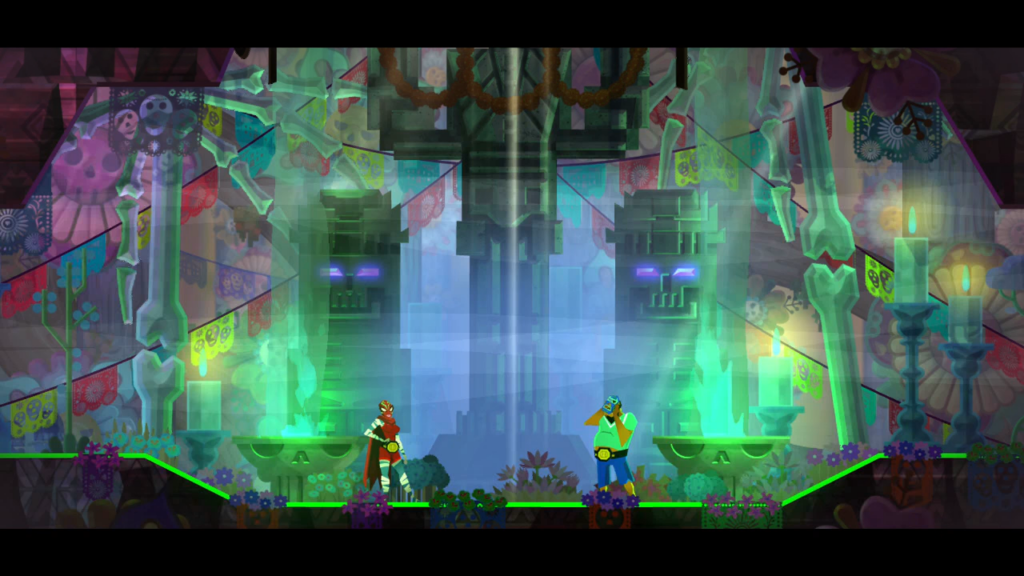
It’s a trite practice to criticize a sequel for being too similar to its predecessor. I presume most such critics do not make the effort to examine what elements are carried forward and refined into something bigger, deeper, and more meaningful. How successfully these refinements are accomplished is often the difference between a good sequel and a great one. In the particular case of Guacamelee! 2 I have to concede that the accusation is not hyperbolic. This is a remarkably similar videogame to the first Guacamelee!
The customary emptying of the player character’s ability set at the start of a new adventure is justified here by Juan’s seven years of idleness and that the magical mask he wears comes from a different timeline. As I guide Juan through this new timeline in the Mexiverse, he reclaims all of the abilities he lost during his years of obsolescence. Juan learns four wrestling moves, one for each direction of the joystick. He also learns to double jump, to swap seamlessly between the Living and Dead worlds of Mexico, and to transform into a chicken which lets him into tiny spaces and narrow crevasses strewn across the map. Every ability returns without revision or complication.
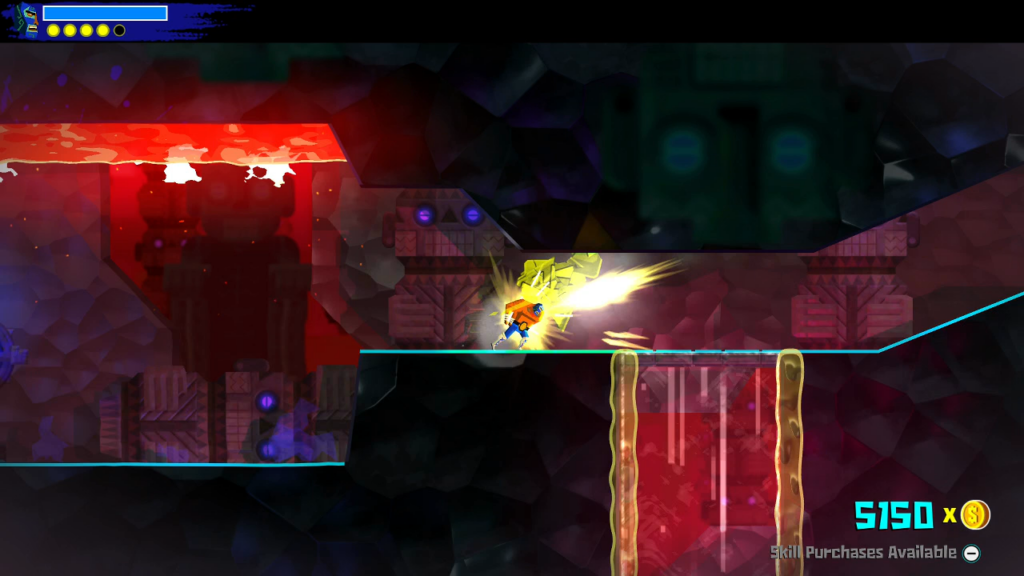
Bringing forward the same core set of skills means the world design is broadly the same as well. It has a new, original map, but most of what it contains are ideas already explored in the first videogame. The Guacamelee! series dispenses with the non-linear platforming trope of hidden passages behind breakable walls. Instead, passages are covered by large color-coded blocks; the color denotes which of Juan’s wrestling abilities will break it. These blocks are obvious and automatically marked on the area map when Juan passes by them. In typical genre fashion, he must backtrack to previous areas to claim the rewards hidden there once he has learned the wrestling skills needed to reach them later in the story.
A quality shared between all non-linear platformers is the more a player explores the map, the more powerful their player character becomes. Exploration means upgrades, and upgrades mean power, so exploration transitively means power. The Guacamelee! videogames demystify the locations of its upgrades, but complicates them by putting additional platforming challenges between Juan and his prizes. This choice shifts the emphasis of my experience from exploration to skill. It’s not enough to guide Juan to a location for him to grow more powerful. I must also help him endure a platforming gauntlet to earn the right to that power.
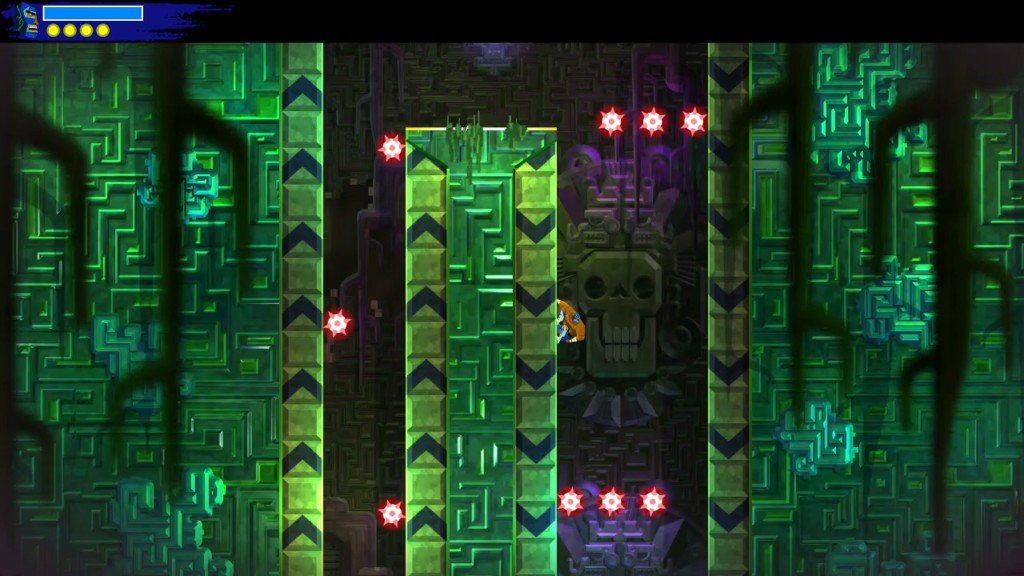
What elevates Guacamelee! 2 is how Juan’s familiar moveset is driven to new levels of complexity and difficulty in these individual platforming challenges, with level design correspondingly pushed to new creative heights. Tunnels lined with conveyor belts must be run against with exact timing to avoid curtains of deadly red orbs that periodically flood the space. Waves of interdimensional energy glide across rooms, forcing Juan to maneuver an obstacle course where a safe spot can shift into a deathtrap at any second. Some of the most titanic challenges require all of Juan’s skills to ascend to the highest points in Mexico, running up vertical walls in his human form, jumping away to glide in his chicken form to a safe landing in another dimension, then rocketing away again to avoid the spikes which erupt from his landing perch.
Checkpoints are always placed at the start of every challenge, ensuring I can keep retrying as many times as I need to finish them. Many of these challenges require such precision that I need several dozen retries before I accomplish them. They never punish me with long walks or repeating fights against enemy groups.
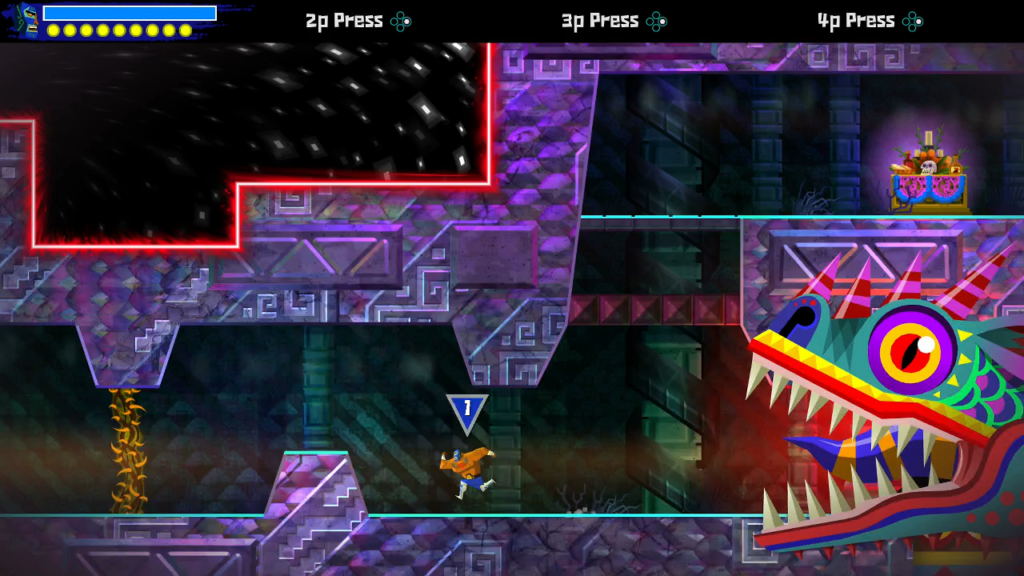
What’s frustrating is that if these extra challenges are ignored, much of this extra creativity is absent from Guacamelee! 2’s core path. Like Juan’s moveset, this version of Mexico feels like a retread of what he explored in the first installment. Visually, Mexico is as beautiful as it always was, full of color and appealing shapes made up of sharp corners and irregular angles. New lighting and reflection effects give some visual flair, making it feel fresher in comparison. In terms of feeling like Juan is occupying a definite place, everything blends together. After spending more than ten hours cavorting through Guacamelee! 2’s spaces to save the Mexiverse, I can recall few of its specific areas. This Mexico isn’t memorable, whether in comparison to the Mexico of Juan’s first adventure or judged on its own merits.
Where the platforming challenges have strained to a new level of intricacy, the same cannot be said for the combat. Though the fighting systems are as good as they were in the first Guacamelee!—and they are incredible—the reach to put them into dynamic new scenarios doesn’t feel as pronounced. Juan will often enter a space somewhere in the world and find himself suddenly boxed in by impenetrable walls. “Lucha!” flashes on screen and he is subjected to an impromptu wrestling match against a pack of skeletons, cryptids, and other assorted monsters.
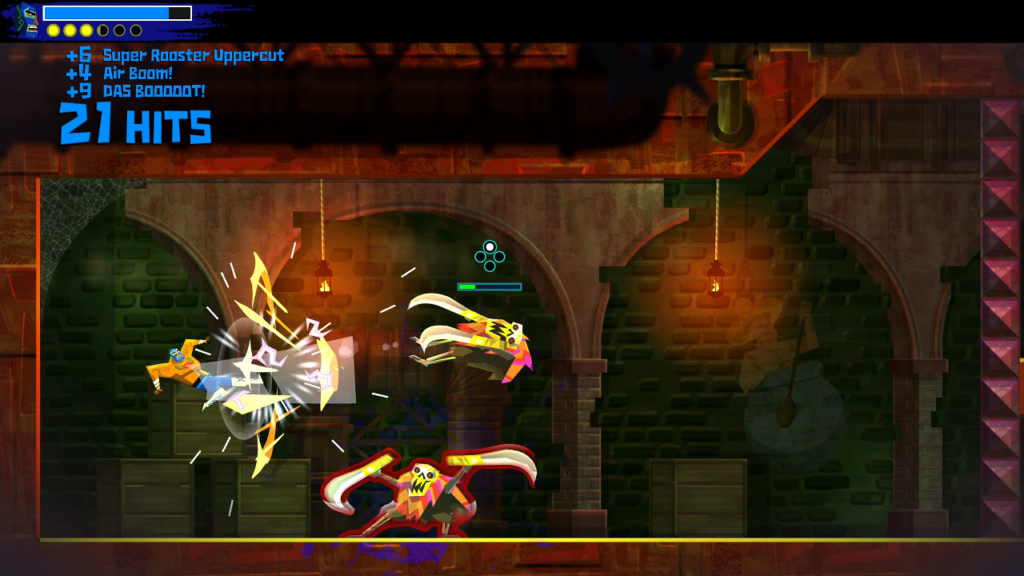
Juan’s enemies have learned no new tricks in the seven years since his first adventure. Many are protected by color-coded shields which must be shattered by one of Juan’s wrestling skills before they will take damage. Others have impenetrable defenses and Juan must dodge-roll past one of their attacks before they become vulnerable. Once Juan can get a hit in, he is able to toss entire enemy groups in the air and juggle them between punches, grapples, and throws. It’s a wonderfully airborne combat system that captures the high-flying spirit of real life lucha libre. It’s still a fantastic combat system, but throughout Juan’s adventure, not once do I feel like he is doing something I haven’t seen in his previous quest.
It would be unfair to dismiss Guacamelee! 2 entirely as a rehash. It does introduce a few new elements. Most significant is the Eagle Boost, a new kind of jump that launches Juan from anchor points in the environment’s backdrop. These often appear midway through intricate platforming sequences, requiring precise timing and positioning to ensure Juan is launched towards his destination and not into a wall or a set of spikes.
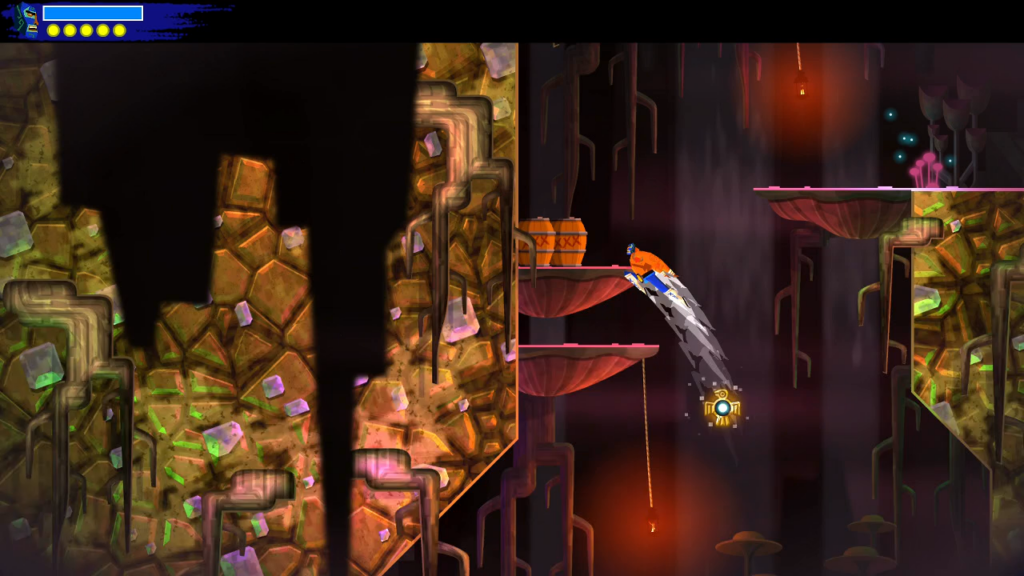
By retaining the ability to grapple and throw enemies and learning two form-exclusive special attacks, Juan’s chicken form is now a viable option in combat. A few areas that lock Juan into this form take advantage of its expanded capabilities to create their combat challenges. It’s nice that the chicken form no longer feels like a restriction in combat, but its new special attacks have a larger impact on platforming. Once again, Guacamelee! 2 chooses to put its effort into expanding platforming more than combat.
Instead of upgrading his abilities by spending coins at the many checkpoints strewn across Mexico, Juan is supported by five different wrestling trainers. Each trainer supports a unique upgrade tree which focuses on a specific set of his abilities, such as Juan’s health and stamina, his wrestling punches and slams, and his grappling skills.
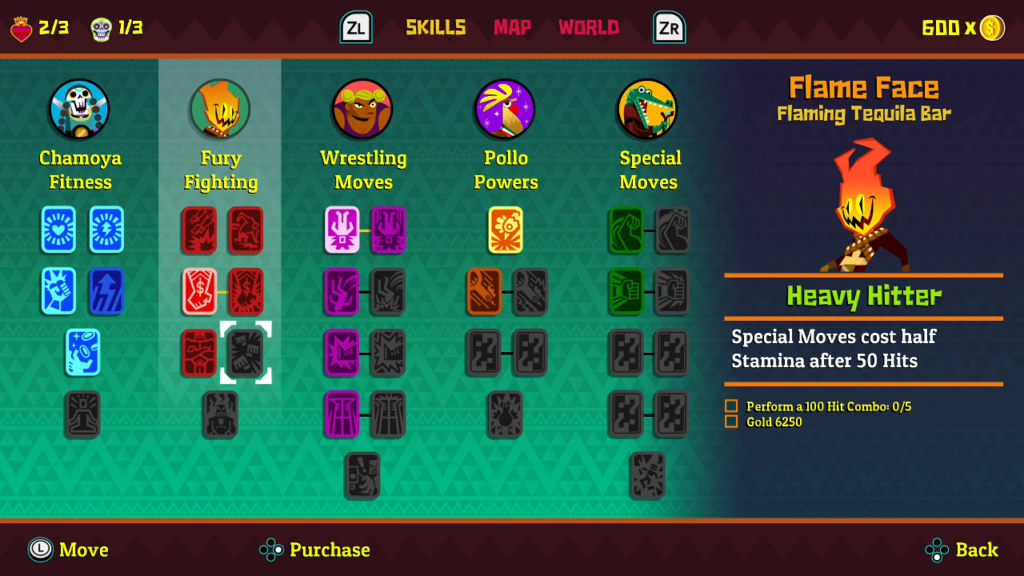
The most interesting difference with these upgrades is most are locked until Juan accomplishes a related task. To purchase the upgraded form of the Rooster Uppercut, he must defeat a certain number of enemies with its standard form first. Several locked abilities require a notable amount of effort and skill to earn their keys, such as reaching a 100-hit combo multiple times. Guacamelee! 2’s combat may not offer anything new, but at least it creates fun milestones and challenges for me to reach for while it’s not being offered.
The biggest change between predecessor and sequel is, of course, its villain. When he is introduced, Salvador has promise. In contrast to Carlos Calaca, who was broadly and despicably evil, Salvador is a tragic mirror of Juan. In his timeline, Salvador’s transformation into a magical luchador allowed him to defeat Carlos, but his mask also steadily drains the life force from his body. With his death inevitable and imminent, Salvador cannot enjoy his victory the way Juan has. His only hope is to acquire an artifact with even greater power than his mask, one that will make him the master of all time. In his desperation, he does not care that his efforts are endangering the stability of every timeline in the Mexiverse.
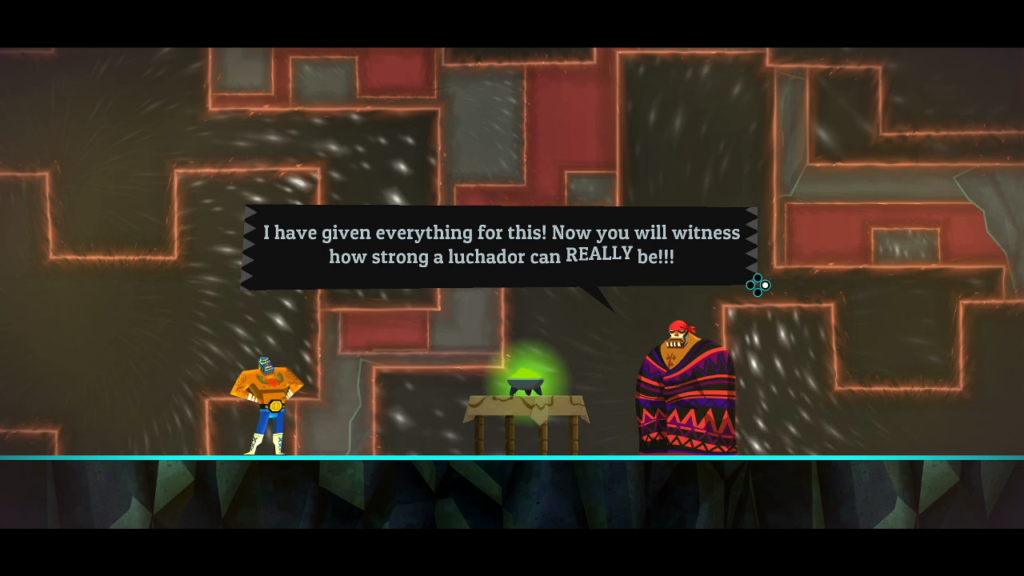
Salvador doesn’t have much of a presence throughout the adventure. His few appearances do little to make me care about him or his situation. A tragic figure I feel no sympathy for is a failure as a tragedy. Salvador is a poor antagonist.
In my review of the first Guacamelee! I fretted about its use of Mexican culture and stereotypes. It portrays a world where every person speaks fluent Spanglish, lucha libre is a religion worshiped in Catholic-style missions attended to by friars with bowl cuts, and Juan claims his post-battle rewards by breaking open a pinata. It hovers uncomfortably between parody and caricature. Ultimately I conclude, “I cannot say the jokes are right, but I am more certain that they are not wrong. This suggests Guacamelee! was made with care, and for that its humor has my cautious admiration.”
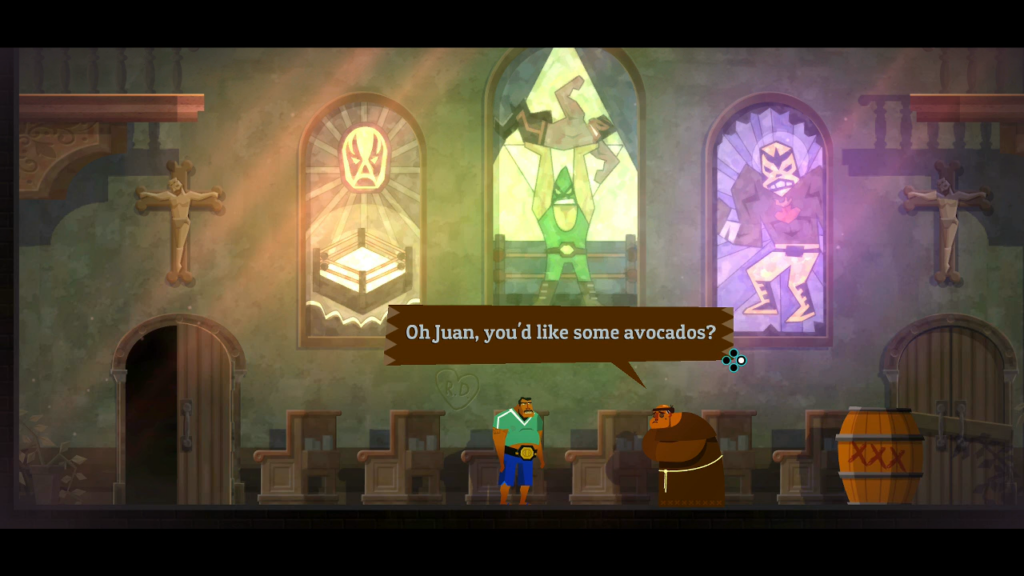
All of these elements are brought forward into Guacamelee! 2, yet here they do not feel like they form the essence of a world. They feel more like an affectation, like generic monsters have been outfitted with sombreros, ponchos, and sarapes in psychedelic colors to make them fit into a Mexican-flavored land. Guacamelee!’s Mexico feels authentically Mexican; Guacamelee! 2’s feels like visiting a land at a local amusement park festooned with red and green paint, a few cactuses, and a looping mariachi soundtrack. I recognize the trappings, but I do not feel its spirit.
It’s in the specific details of Salvador’s evil plan where I most feel Guacamelee! 2’s use of Mexican culture loses its affectionate angle. After managing to collect all the quest’s macguffins, Salvador assembles them into a jagged triangle and absorbs their power by eating it like a tortilla chip, complete with guacamole dip. This is played as a whimsical sight gag, but its execution feels like the last ounce of pressure snapping the comedy tension. It’s not affectionate ribbing at a Mexican stereotype. It’s a desperate last joke. What do Mexicans eat? Tortillas with guacamole. How will the villain destroy the Mexiverse? By eating a tortilla with guacamole. It’s not funny, even in concept. It’s where Guacamelee! 2 really feels like it slips away from its solid foundations and makes me wonder in hindsight if I gave too much credence to the first installment’s authenticity.
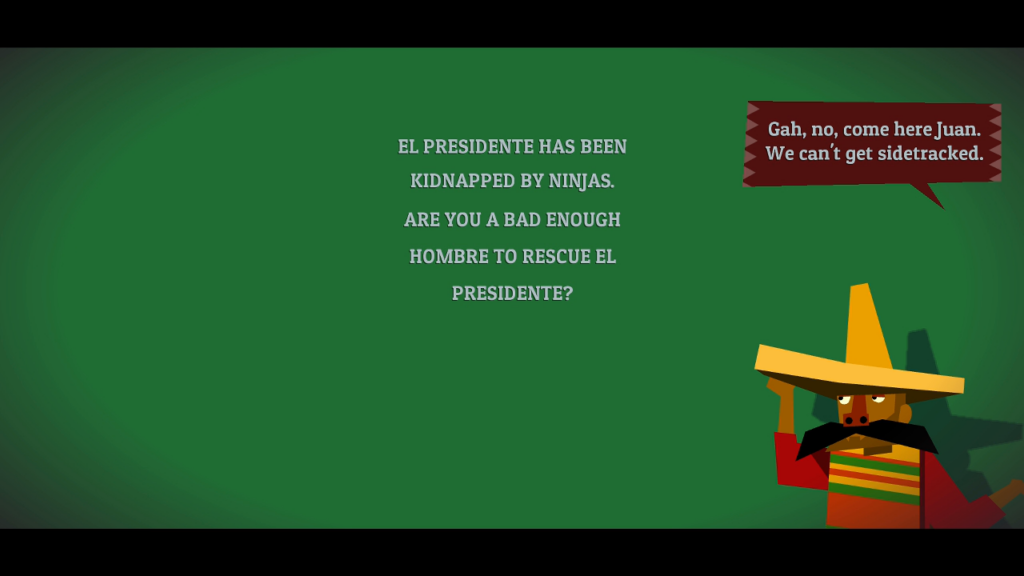
The effort to portray Mexico in an affectionately humorous light seems to have been moved into another area of comedy. Videogame parodies were a source of frequent levity throughout the first Guacamelee! They were prevalent, but they did not steal the spotlight. Guacamelee! 2 expands these parodies until they become the new comedic centerpiece. I am confronted with this fact right away.
When Uay Chivos appears in the introduction and summons the out-of-shape Juan back into action, he pulls the player character through a door into another dimension. The trip goes awry, and Juan briefly visits a timeline made up of shadow and darkness where anything moving is menaced by slender, jagged legs that stab in from offscreen. The next portal sends Juan to a world where a man asks, “El Presidente has been kidnapped by ninjas. Are you a bad enough hombre to rescue El Presidente?” Before Juan can respond, he is pulled through another door and finally deposited back into his own plot.
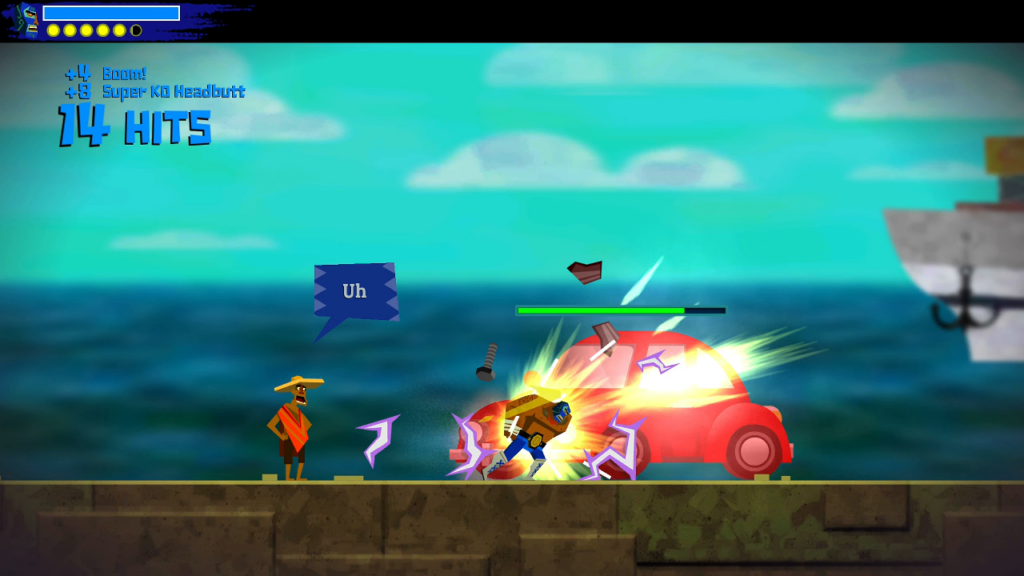
The concept of the Mexiverse suggests that Juan will be pulled into many different variations both of his own and Salvador’s versions of Mexico. Instead, the other universes Juan visits are all videogame parodies. One briefly turns the adventure into a turn-based RPG. Another satirizes monetization mechanics common in mobile videogames. In a particularly memorable misadventure, Juan visits a world filled with non-player characters who all quote actual negative reviews for the first Guacamelee! This world feels especially mean-spirited. Guacamelee! is a fantastic and successful videogame, so taking the time to highlight its more outspoken haters feels like punching down, which never reflects well on the puncher. Juan should be hefting his weight for good, not for evil.
While the videogame references in the first Guacamelee! were prevalent, I do not feel like they remove Juan from his place in Mexico. The parodies in Guacamelee! 2 feel like speedbumps. Destroying some poor guy’s car (twice) is amusing, but it doesn’t add anything to Juan’s adventure. It’s just a videogame reference existing for its own sake, taking up space.
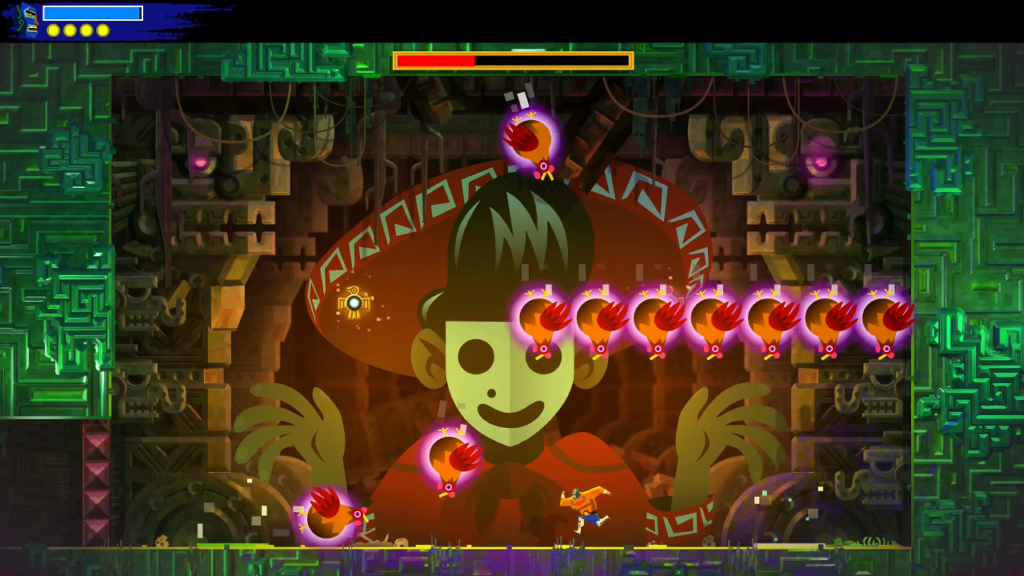
I wanted to write a more glowing review of Guacamelee! 2. I believe this is an excellent videogame. It’s worth playing for its platforming challenges alone. Too many of its other elements are disappointments. It takes the cohesive whole of platforming design, combat design, plot and characterization, and sense of humor, and stacks too much of its brilliance in just one category. The combat is as great as it was in the first Guacamelee! but feels hardly different. The plot is forgettable and the new characters moreso. The biggest stumble is the comedy. The parodies of Mexican culture, which already concerned me before, now feel shallow and obvious. The videogame parodies are more prominent and distract where they should embellish. I recommend Guacamelee! 2 for its incredible platforming, but be forewarned of its other shortcomings.